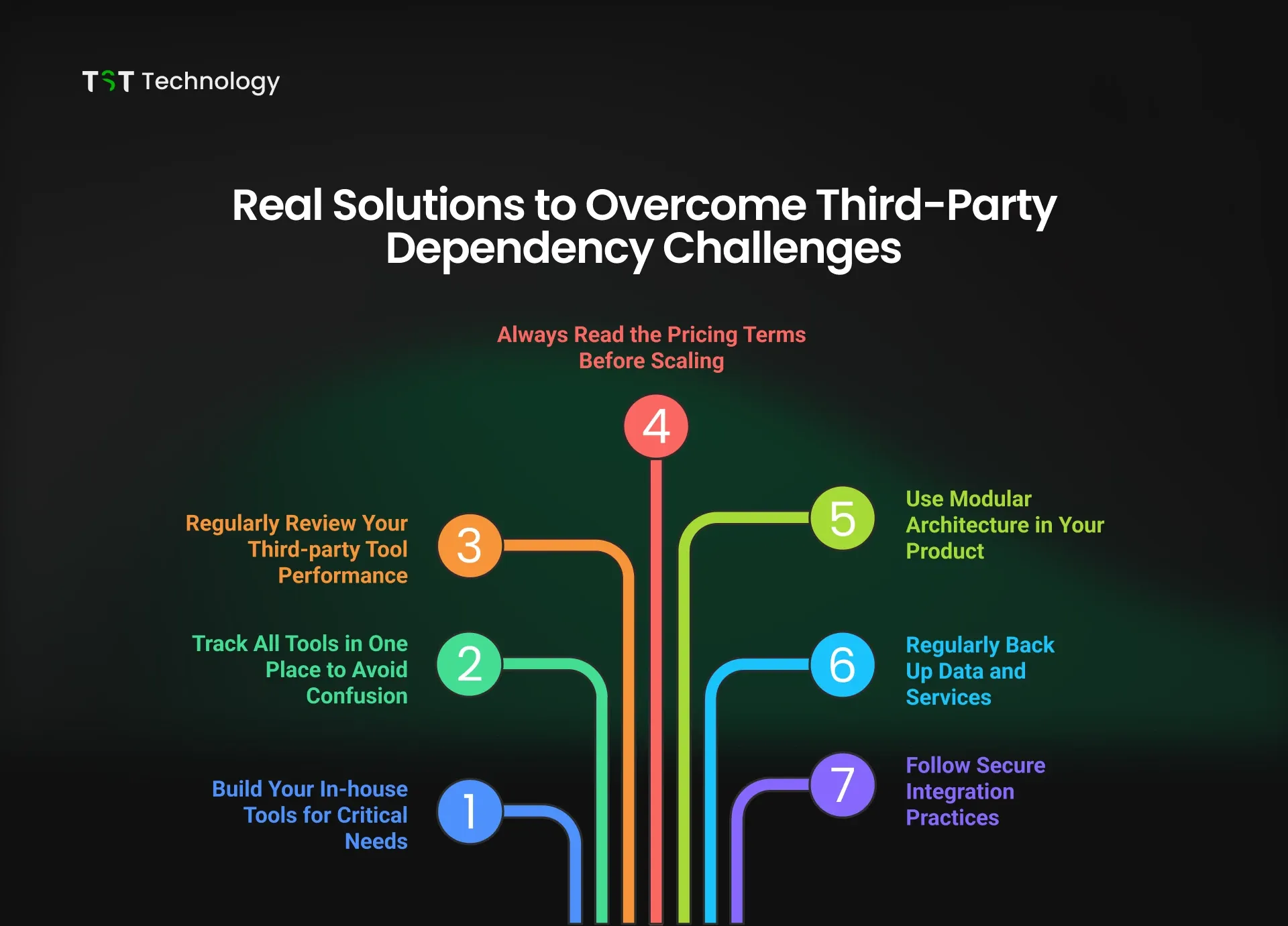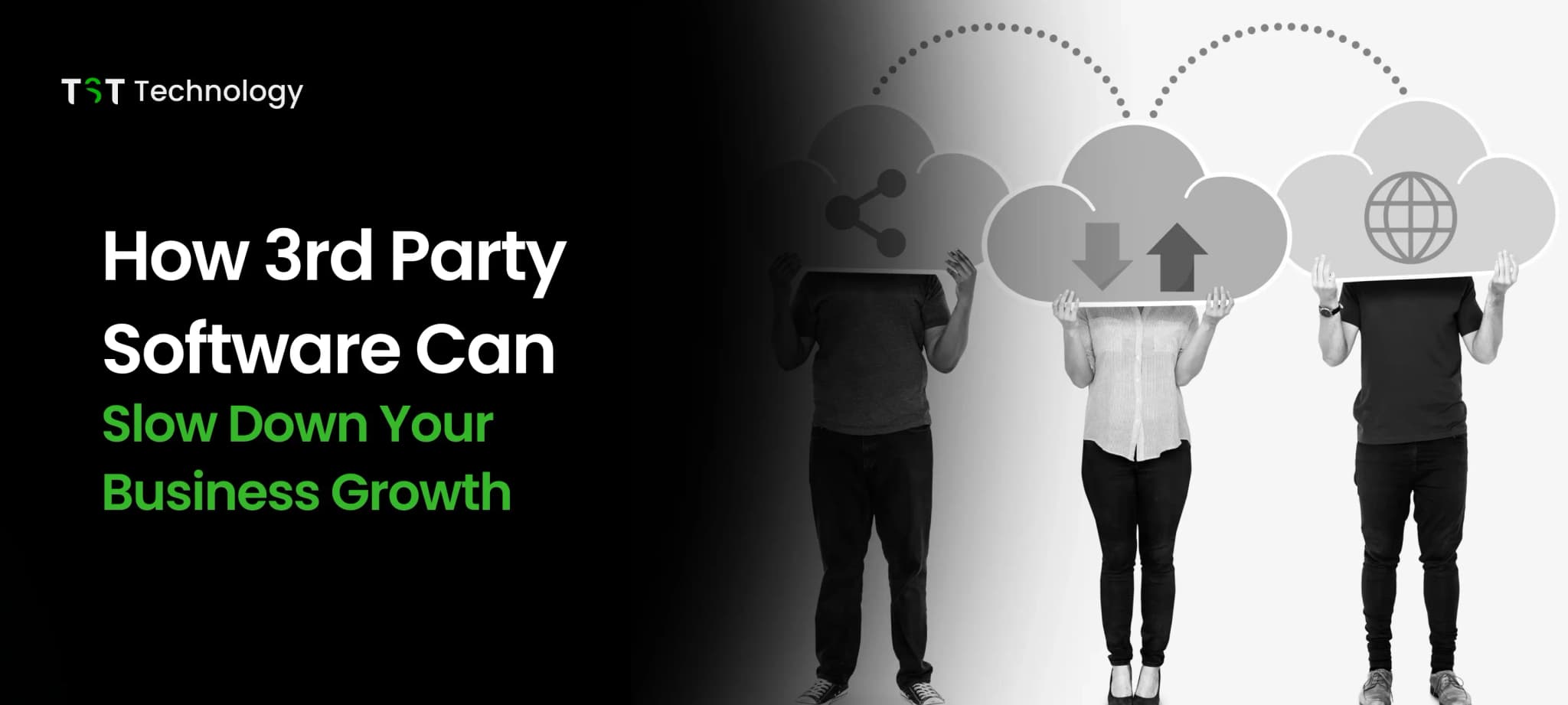What If Your Growth Problem Isn’t You- but Your Tools?
Here’s what no one tells you!
At first, these tools help you save time and effort.
The shocking truth is that these tools help you save time and effort.
But as your business grows, these tools might be slowing you down.
- Delays, rising costs & less control
- Unplanned tech problems
- Growth getting stuck? Yes, it happens!
In this blog, you’ll discover:
- Top 11 problems of using third-party software
- Real-world problems companies faced
- Simple ways to take back control
Top 11 Common Problems When Scaling with Third-Party Dependencies

When companies start growing, they often use third-party software to save time and money. But as the business scales, these tools can create problems instead of solving them.
Here are common issues companies face with third-party software components:
1. Tool Crashes or Downtime Affect Your Business
- If a third-party tool stops working or crashes, your business also stops. You can't control their system, so it’s risky during busy workdays.
2. You Can't Change or Customize the Software as Per Your Needs
- Most tools give fixed features. You can't easily add or remove things based on your own company's needs, which creates limitations.
3. You Pay More as Your Team or Data Grows
- As your usage increases, you have to shift to expensive plans. Many times, you pay for features that you don’t even use.
4. Slow Support from Third-party Support Teams
- When there’s an issue, you have to depend on their customer support. Many times, the reply is slow, and the issue takes days to get fixed.
5. Data Privacy and Control are Not in Your Hands
- Your team and customer data are stored on someone else's servers. This can be risky if they don’t follow strong security measures.
6. One Small Change Can Break Your Whole System
- If they change or update their API or system, it can affect your integration and break your features unless you keep fixing it regularly.
7. Too Many Tools Can Make Things Complicated
- Using multiple third-party software programs together can cause confusion, delay, and miscommunication between teams.
8. Dependency Creates Long-term Risks
- If the company behind the software shuts down or increases prices, you’re stuck. You will need to spend more time and money to replace it.
9. Poor User Experience for Your Team or Clients
- Some tools have a complex design or are slow. This makes it harder for your team or users to work smoothly.
10. It Doesn’t Match Your Business Flow
- Every company has its way of working. A general tool may not fit your exact process, and adjusting your workflow around it is not efficient.
11. Scaling Becomes Slower and Harder
- As your team grows, your needs increase. If your tool can't handle the extra load or new features, you get stuck and cannot move fast.
Third-party tools are good in the beginning, but depending too much on them can create serious problems later. They can limit your speed, flexibility, and control as your business grows.
Real Solutions to Overcome Third-Party Dependency Challenges

When your business grows, relying too much on outside tools can slow you down. But with proper planning, you can reduce these problems and gain full control.
Follow these steps:
1. Build Your In-house Tools for Critical Needs
- If a tool is very important for your daily work or customer experience, try to build it yourself. It gives you full control, more flexibility, and no future risk of downtime.
2. Choose Tools That Offer Open APIs and Easy Integrations
- Pick tools that are easy to connect with other software. This reduces future technical issues and gives your team more control over how data moves.
3. Track All Tools in One Place to Avoid Confusion
- Maintain a list of all tools your business is using, along with pricing, support details, and usage. This helps avoid overlapping tools and saves money.
4. Regularly Review Your Third-party Tool Performance
- Every 3–6 months, check whether the tools are helping or slowing you down. Replace or upgrade tools that are not scaling with your growth.
5. Always Read the Pricing Terms Before Scaling
- Understand how the cost will increase as your team, data, or traffic grows. This helps you avoid surprises in your monthly bills.
6. Use Modular Architecture in Your Product
- Design your software in small parts (modules) so you can replace one tool without breaking the whole system. This makes scaling easier.
7. Regularly Back Up Data and Services
- Keep backups of all important data and services provided by third-party tools. This ensures that if something goes wrong, you can restore operations quickly without losing critical data.
8. Follow Secure Integration Practices
- Always use secure methods while connecting third-party tools. Use encryption, access control, and regularly update your integration methods.
Third-party tools can be useful, but smart companies know where to draw the line. Don’t let these tools control your business growth.
Invest in your systems where it matters, train your team, and stay prepared for unexpected issues. That’s how you scale confidently without depending on others too much.
Real-Life Case Studies of Scaling Problems with Third-Party Tools
1. Building Our HRMS Software to Overcome 3rd-Party Tool Dependency

Problem: Depending on 3rd-Party HR Tools Like Keka Created Challenges
As our team grew, we used third-party HRMS tools like Keka to manage leaves, attendance, and employee data. But over time, we faced several challenges:
- We couldn't customize the tool based on our internal needs and team structure.
- We were paying for features we never used, which increased monthly costs.
- The user experience was slow and not friendly, especially for simple tasks like checking leave balances or daily clock-ins.
- There was limited control over data privacy and internal reporting.
- As our team scaled, these small issues started affecting efficiency, budgeting, and team communication.
Solution: We Built Our Own HRMS Platform
To overcome this third-party dependency, we decided to build our own in-house HRMS software tailored to our needs. Here's what we added:
- A dashboard showing live attendance, team progress, and real-time working hours.
- Leave management with clear visibility of Sick Leave, Paid Leave, and Unpaid Leave balances.
- A simple interface to view who is absent, on leave, or working remotely.
- A search teammate feature and upcoming holiday reminders like Foundation Day.
- Everything was built with full control, better speed, and an easy interface for our team.
Result: Full Control, Better Experience, and Cost Savings
- After switching from third-party tools to our own HRMS, we noticed:
- A more personalized experience for team members.
- We saved costs by avoiding extra features we never used.
- Our HR processes became faster and smoother, especially for remote and hybrid work.
- We had complete control over updates, features, and team data.
2. Kardashian Apps Faced User Data Leak Due to API Issue

Problem
The Kardashian and Jenner sisters launched mobile apps for fans to view exclusive content. But just after launch, a big problem happened. A weak API system allowed users to access the private data of other subscribers. People could easily see the names and email addresses of thousands of users.
Solution
The issue was found by a 19-year-old tech founder who noticed the security gap. The company managing the apps quickly fixed the problem. They stopped open API access and added safety rules to stop anyone from viewing data without permission.
Result
The user data was protected again within hours. This case showed the risk of using open APIs without safety checks. It became a strong example of why every API should be secure before launching an app.
Key Lesson
Always test your API for safety. If the API is not secure, it can leak sensitive user data and harm your brand's trust.
3. Flipkart Improved Deliveries Using Smart API Integration

Problem:
Flipkart faced challenges with its delivery system, relying heavily on third-party APIs for logistics. These third-party integrations caused delays and inconsistencies, which affected customer satisfaction and operational efficiency. The reliance on external software slowed down their ability to scale and meet growing demands.
Solution:
To overcome these issues, Flipkart decided to develop and integrate its own API for managing deliveries. This allowed them to have greater control over the entire logistics process, improving both speed and accuracy.
By building an in-house solution, they eliminated delays caused by third-party systems and ensured smoother operations.
Result:
As a result, Flipkart saw a significant improvement in delivery times and reduced errors, which led to a better customer experience. This move allowed them to scale faster and gain more control over their operations, ultimately helping them grow without being slowed down by unreliable third-party software.
Key Lesson
Depending too much on third-party software can slow down your growth, but building your own tools gives you more control, faster performance, and better results as you scale.
Conclusion
When your business is small, third-party tools feel like a quick and easy fix. But as your team, users, or data grow, these tools can become roadblocks. That’s why it’s important to plan smartly and build your solutions where it matters most.
If you’re facing issues with third-party tools or want to build custom solutions for your team, we’re here to help– let’s talk!
Thanks for reading- see you again with more helpful blog posts!






